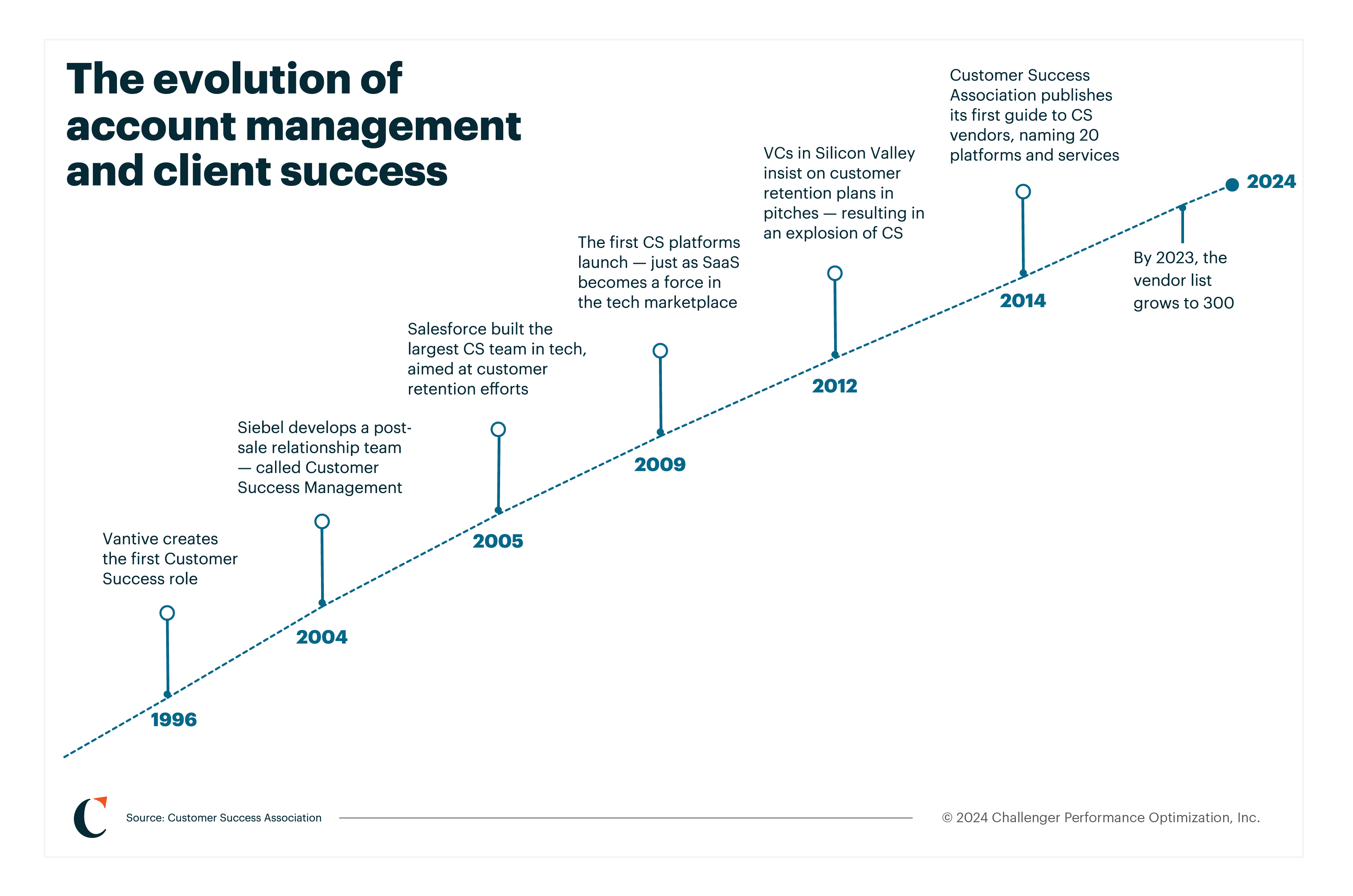As go-to-market (GTM) teams have grown and evolved, so too have our perceptions of “pre-sale” and “post-sale” roles. Customer success and account managers must now focus beyond retention to emphasize expansion and growth.

These new rules of account growth dictate a new approach. To meet their goals, account managers need to channel new logo sellers. But don’t panic: By learning to challenge customers and deliver Insights, Challengers set themselves in front of the competition and find new approaches to grow business. Let’s dig into the shifts in account management that necessitated this change, what it means for GTM teams, and easy strategies to get started.
The evolution of customer success
The idea of customer support isn’t new, but client success and account management functions are, relatively speaking. The first CS role emerged in 1996 at a company called Vantive. In 2005, as Salesforce grew rapidly and acquired both new customers and other companies, they recognized a need to address increasing levels of customer churn and built out a real customer success team. This team reflected the early function of CS teams: focusing on renewals and retention for CRM companies.
Eventually, venture capital investors recognized the value of scrutinizing retention plans in the same way they prioritized a startup’s approach to new business. After all, it’s much easier to grow business from existing accounts than to start fresh with new ones, right? Well, that’s overstating it a little.

What really drives account growth?
Today, as the CS field grows, account managers and customer success teams face new challenges. Increasingly, they must balance retention and service delivery with growth. In this clip, Challenger Account Director Megan Dolan looks at how renewals and expansion fit into a typical AD’s quota in 2021 and how those expectations evolved in 2024 in our recent Winning The Challenger Sale Webinar “Reframing Account Management for Growth.”
So, what strategies can help them get there? In 2018 and again in 2023, Challenger surveyed account managers and sales leaders to find out what they thought contributed to growth. Eighty-eight percent of those account managers replied that great service was the biggest driver. Yet, our research shows that only 28% of sales leaders are regularly reporting meeting account growth targets.
In short, while reps report that service yields growth, sales leaders report that strategy isn’t working. How do we explain that discrepancy?
As we know from the original Challenger research, it all comes back to the customer experience. The sales experience is the single biggest driver of customer loyalty. A Challenger sale sets your company up as the kind of trusted advisor that can partner with clients to bring them Insights they aren’t seeing elsewhere. Carrying that support forward is key to growing accounts. As Marinus Maris, our General Manager of International Sales, says, the key is not customer service but customer improvement.
“The metric you want your customers to have in their mind is, ‘I can’t live without this person because what they’re bringing to me is insightful,’” Marinus says.
For Challenger sellers, this means continually bringing Insights to the table, looking ahead to unforeseen blockers, and helping them navigate internal and external threats.
“It’s far more profitable to go after your existing base,” Marinus says. “One of the expressions that we use in the team here is that the customers you want are like the customers you already have.”
Yet, as Megan shared, it’s not enough to deliver Insights and improvement.
Strategies for approaching expansion like new business
First, we recognize that most CS professionals didn’t choose that career path because they enjoy cold calling or even engaging in sales conversations. At the same time, most sellers — unless they’re those fantastic Problem Solvers — don’t thrive in a post-sale environment.
That’s why the first step in successfully growing revenue with existing accounts is a strategic shift in the way your GTM team approaches growth. Just look at how sales leaders attending our recent webinar responded when we asked how their teams shake out.

Whether you divide your teams into pre and post-sale or not, it’s critical that everyone sees growth as a shared responsibility of a holistic GTM team. From there, leaders can begin coaching their CS and AD teams to push the boundaries of what they might naturally consider “account management.”
Dig into your clients’ success metrics
According to research from LinkedIn and Ipsos, 78% of B2B buyers rated sellers “aligning with [them] on success metrics related to purchase” as very important in a sales engagement. Customer success and AD teams tasked with growth should know those metrics, too — and should use their ongoing connection with customers to dive beneath the surface.
Hear more in this clip from Megan.
Get comfortable moving beyond the main points of contact
Next, CS and AD teams must partner and plan to break into new business units at existing clients. Often, that means getting comfortable moving outside their main POCs.
When Megan wants to begin a conversation with a stakeholder in a new business unit, she reaches out on LinkedIn and sends resources to key contacts. Crucially, these resources aren’t about the product — they’re directly related to those stakeholders’ interests. She also asks for introductions and sometimes makes them herself.
“I’m often connecting people at the same organizations and actually brokering meetings between them,” Megan says. “It’s up to us to create that bridge, that off-ramp, to get them to the same destination.”
Of course, your points of contact may not welcome this approach, at least at first. You may hear them ask, “Why are you reaching out to so-and-so?” But remember that Challenger sellers don’t pursue relationship building for its own sake. They build relationships, yes, but they build them around commercial growth.
“It’s about those interactions between the workshop or the training where we can help them overcome roadblocks they weren’t even aware of,” Megan says.
Deeply understand the business and identify new opportunities
To grow accounts, account managers must understand what the customer cares about across multiple business units. Look at the company website, understand its segments and organizational charts, and speak to the broader problems facing the industry. Don’t forget to read financial statements and annual reports. Megan particularly likes turning to podcasts, LinkedIn posts, or product launch videos.
“It’s a minute and thirty seconds straight from a C-Level or from an executive,” Megan says. “When you reach out to that person, you can let them know you saw their video.”
Then, return to your Challenger skills and use that knowledge to disrupt their status quo. This is about identifying the problems they haven’t thought about, and it allows account directors to elevate their credibility and build a path to growth.
“Then they can think back to: Megan helped me with this,” she says. “And that sets up that fantastic experience that we discussed, one that’s based not on service, but on growth.”
Turning account growth into a strategy that wins
The new rules of account growth dictate that pre- and post-sale teams must align closely together if they want to achieve ambitious growth goals. As the lines between sales and CS begin to blur and disappear, Challenger-trained account managers and CSMs will find themselves a step ahead. They can use tailored Insights to build on a strong sales experience in a way that centers relationships around customer improvement, not just customer service.
For more, check out our on-demand Winning The Challenger Sale Webinar, “Reframing Account Management for Growth.”
Challenger, Inc.
Challenger is the global leader in training, technology, and consulting to win today’s complex sale. Our sales transformation and training programs are supported by ongoing research and backed by our best-selling books, The Challenger Sale, The Challenger Customer, and The Effortless Experience.
More from our blog
3 Challenger Skills That Boost Sales Rep Productivity and Motivate Buyers
Sales leaders everywhere are looking for ways to improve sales rep productivity. But productivity isn’t just about efficiency—it’s about…
Sending Commercial Teaching Messages That Inspire Action—Not Anxiety
How to Build Tension in Your Commercial Teaching Message In B2B sales, the most powerful messages aren’t horror stories, they’re dramas with a clear…
The Next Era of Challenger Selling: Skills That Will Shape the Future of Sales
In 2020, selling changed overnight. Buyers went quiet, priorities flipped, and digital interactions replaced boardroom handshakes. Everyone talked…
What are you waiting for?
Transform your sales team.
The best companies grow, and grow fast, by challenging customers, not by serving them.




